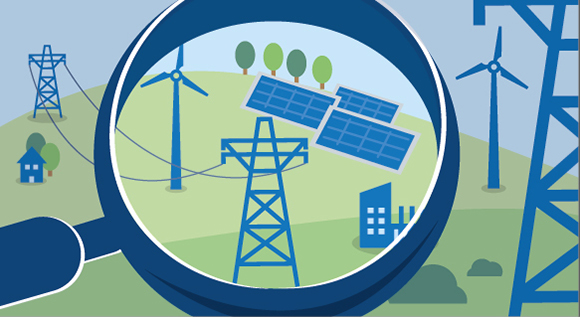What exactly are ‘HVDC transmission lines’?
The grid expansion will increase the number of HVDC transmission lines. But what do these four letters stand for? Read on and find out.
 © BMWi
© BMWiMoving large amounts of electricity around the country
For the energy transition to succeed, the transmission grid will need to be able to transport large amounts of electricity over long distances while keeping energy loss as low as possible. Some of the electricity flowing through the grid will end up heating the power lines, resulting in lost energy during transport. You will be familiar with the problem from old light bulbs: some of the energy ends up heating the bulbs instead of being converted into light.
In order to keep this energy loss as low as possible, the power lines need to be operated at a high voltage and in such a way that electricity only flows in one direction. HVDC transmission lines combine both of these factors. (HVDC stands for high-voltage direct current.) Let us take a look at these two factors.
A high voltage is crucial
Basically, the higher the voltage, the lower the energy loss during transport. We therefore need to operate the lines at the highest possible voltage. The ‘Ultranet’ HVDC transmission line, for example, will operate at 380,000 volts. In comparison, a regional power grid that supplies homes usually operates at only 220 or 400 volts. The newly constructed electricity highways are therefore operating at about a thousand times higher voltage than the lines in front of our homes.
Electricity that flows in one direction
So far, electricity has been transported over long distances as alternating current. Alternating current reverses direction 50 times a second. This change of direction causes energy to be lost. At distances of several hundred kilometres, these losses add up. The electrical current basically runs out of steam. This is a far smaller problem with direct current. Depending on the length, HVDC lines lose 30 to 50 per cent less energy than AC transmission lines.
Higher investment costs are offset
AC transmission lines are still commonly used in overhead high-voltage power lines because they are relatively cheap to build and to maintain, and are also less susceptible to outages. However, some new connections over long distances are now being planned as HVDC lines because the lower energy losses offset the higher investment costs needed for this technology. In particular, the converters that are used to convert the alternating current into direct current (and vice versa) at the beginning and end of the lines are relatively expensive. So far, HVDC lines have usually been seen in underwater cables and offshore lines which connect the wind farms out at sea with the mainland.
The Federal Government adopted the Act to change provisions of law on energy cable construction at the end of 2015, stipulating that underground cables will be given priority over overhead lines in the case of new HVDC transmission lines. This will also make them more likely to be accepted by the public, as underground cables have less of an impact on the surrounding landscape than overhead lines. Underground HVDC transmission lines will also be used in the large SuedLink and SuedOstLink electricity highways.

